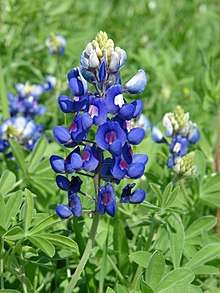Bluebonnet (plant)
Bluebonnet is a name given to any number of purple-flowered species of the genus Lupinus predominantly found in southwestern United States and is collectively the state flower of Texas. The shape of the petals on the flower resembles the bonnet worn by pioneer women to shield them from the sun.[1] Species often called bluebonnets include:
- Lupinus argenteus, silvery lupine
- Lupinus concinnus, Bajada lupine
- Lupinus havardii, Big Bend bluebonnet or Chisos bluebonnet
- Lupinus perennis, wild lupine or blue lupine
- Lupinus plattensis, Nebraska lupine
- Lupinus subcarnosus, sandyland bluebonnet or buffalo clover
- Lupinus texensis, Texas bluebonnet or Texas lupine

On March 7, 1901, Lupinus subcarnosus became the only species of bluebonnet recognized as the state flower of Texas;[2] however, Lupinus texensis emerged as the favorite of most Texans. So, in 1971, the Texas Legislature made any similar species of Lupinus that could be found in Texas the state flower.[3][4]
As an extension of Lady Bird Johnson's efforts at highway beautification in the United States (see Highway Beautification Act), she encouraged the planting of native plants along Texas highways after she left the White House.[5] Bluebonnet blooms are now a common sight along these highways in the springtime.[2] They serve as a popular backdrop for family photographs, and the Department of Public Safety issues safety recommendations with regard to drivers pulling off highways to take such pictures.[6]
References
- "Lone Star Junction". Retrieved 6 June 2013.
- Andrews, Jean. "Bluebonnet". Handbook of Texas Online. Retrieved 15 September 2011.
- "How Bluebonnets became the state flower". Houston Chronicle. Retrieved 15 September 2011.
- Parsons, Jerry M.; George, Steve; Grant, Greg. "Texas Bluebonnets--Texas Pride". Aggie Horticulture. Texas AgriLife Extension Service, Texas A&M System. Retrieved 24 June 2015.
- "Our Environmental First Lady". Lady Bird Johnson Wildflower Center. Retrieved 2015-07-26.
- "Information for th eNews Media" (Press release). Texas Department of Public Safety. 2004-03-11. Archived from the original on 2016-03-04.